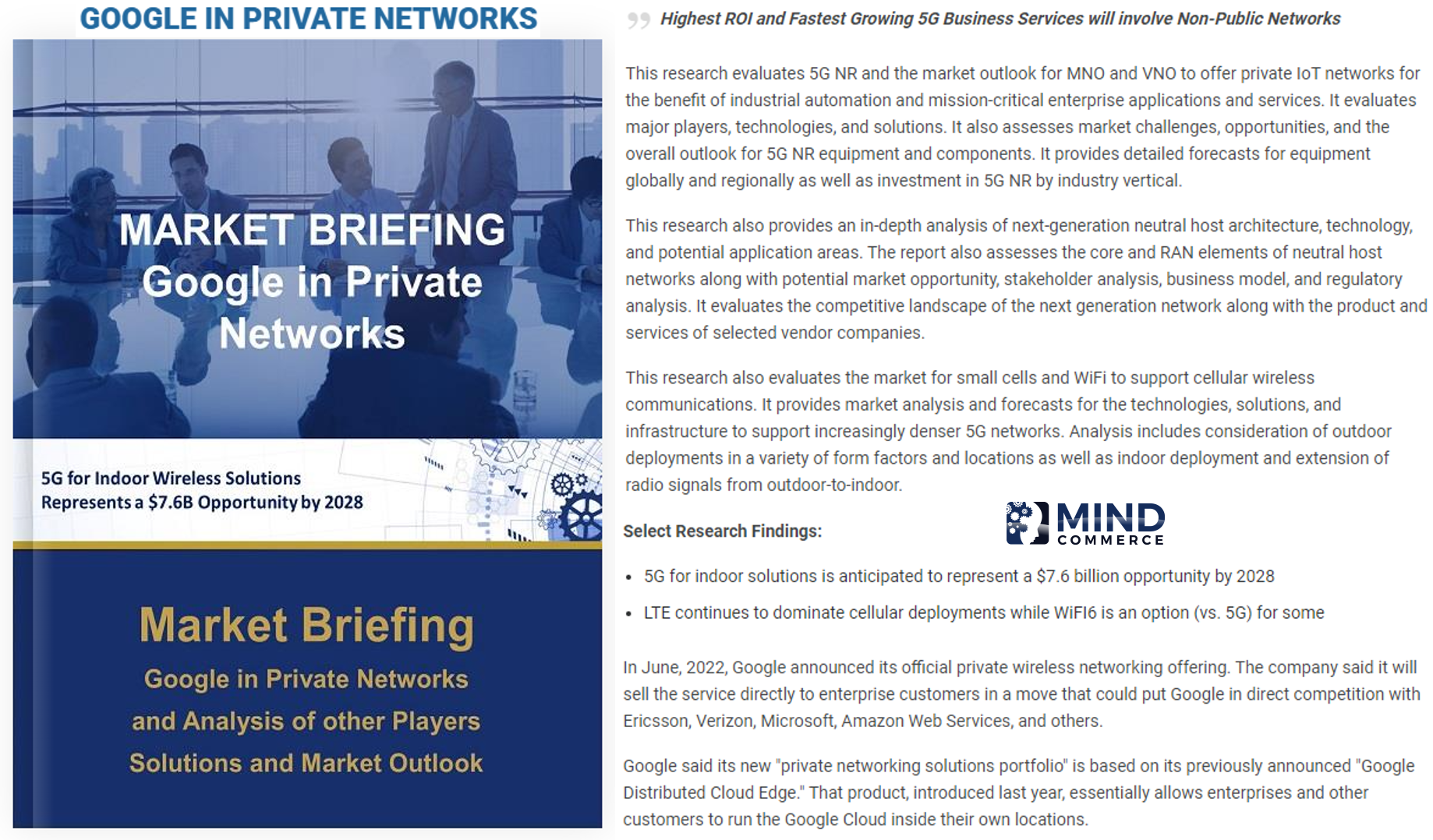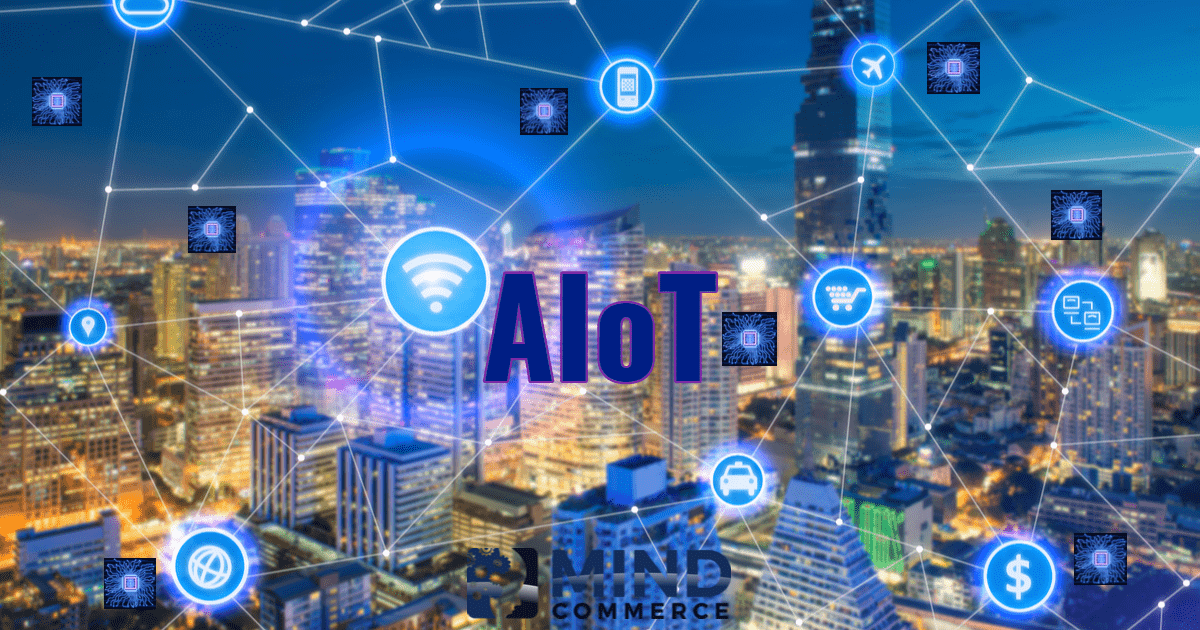Mind Commerce was recently called upon to investigate the 5G, IoT, and edge computing market and to develop a report. The report, entitled 5G, IoT and Edge Compute Trends: Technology Challenges, Solutions, and Forecasts for the Low-latency Edge, may be found at the Futuriom website (click here).
The combination of 5G, IoT, and edge computing will be transformational for both communication service providers and their customers, most notably business clients in enterprise, industrial, and government segments. The consumer market ecosystem will evolve over a longer period of time as compelling applications emerge that both scale and have positive overall ROI.
Taking a rational view of 5G, Mind Commerce does not see 5G as a panacea for legacy communication service providers (CSPs). In fact, 5G will have some downsides for carrier CSPs as Over-the-Top (OTT) app providers and other third-party CSPs will benefit from lower data costs, fueling innovation for many new data-hungry apps for which carriers only derive data revenue and not application or service revenue.
However, 5G is NOT just another “G” It is truly unlike any of the former generations of cellular communications as 5G networks promise to improve many aspects of wireless communications, supporting enhanced mobile services, greater scalability for Internet of Things (IoT) systems, and ultra-reliable communications for mission-critical applications.
Defining Edge Computing
What is meant by the “edge” and “edge computing”?
- Edge computing has its origins in fixed networking, which has arguable been led my cable MSO providers and Over-the-Top (OTT) companies such as Comcast and Netflix to provide network operations such as improved performance of Content Delivery Networks (CDN).
- However, the edge is a matter of perspective. With increasingly powerful processing power of end user equipment, smartphones could be considered the edge of computing in networks. Likewise, customer premise equipment such as an Internet of Things (IoT) gateway could likewise be considered an edge compute node.
As with most everything within the Information and Communications Technology (ICT) industry, there is no shortage of acronyms. Mobile Edge Computing (MEC) is a concept developed by ETSI (European Telecommunications Standards Institute) that aims to bring computational power into Mobile RAN (radio access network) to promote virtualization of software at the radio edge.
ETSI later re-termed “MEC” to refer to “Multi-access” Edge Computing. The intent of MEC is to (1) bring cloud-computing capabilities and an IT service environment to the edge of the telecom networks and (2) bring virtualized applications much closer to end-users as a means of ensuring network flexibility, economy and scalability
In physical terms, the edge can be defined relative to the center, such as computing occurring far away from centralized computational infrastructure. By way of example, a term sometimes used in IoT to refer to decentralized cloud computing is “Fog Computing” (e.g. cloud computing at the edge). Fog Computing is used in a non-cellular context, which is to say that WiFi and other wireless and wired technologies are used for connectivity and communications in support of IoT.
Regardless of the specific terminology or acronyms used, edge computing represents the implementation and operation of computing applications, data, and services away from centralized nodes to the logical extremes of a given network.
However, edge computing is about a lot more than just localization as an edge compute architectural approach allows networks to minimize data hops, packet loss and data re-transmits that lead to latency. In other words, it’s not just local processing – it’s ensuring that there are no throughput delays. Therefore, edge computing is an alternative to high capacity private transport networks, which in aggregate are very expensive. Instead, edge computing provides computation power very close to where it is needed.
With competing architectures between MEC and Fog Computing, it is easy to be confused as a technology buyer or seller. However, efforts have been made to rationalize the edge computing market. By way of example ETSI’s Multi-Access Edge Computing (MEC) Industry Specification Group (ISG) and the OpenFog Consortium (now part of the Industrial Internet Consortium) agreed to cooperate beginning in 2017 with a focus on edge computing APIs.
The decision to start with APIs made sense as they will be critical to the edge computing market for many reasons including the need for open access for provisioning, administering, and managing edge computing enabled applications. Some of the more notable mobile edge computing APIs are Application Enablement API, Radio Network API, Location API, User Equipment API, and Bandwidth API.
The specific architecture employed to support a given edge computing deployment will vary by specification, group, use case, and vendor approach. However, Mind Commerce sees one of the more compelling considerations to be the relationship between 5G and MEC.
Why Edge Computing is Important
Implementation and operation of MEC has profound implications. For example, there will not be a need to always route completely through the entire switching fabric for Internet transport. In other words, certain content and applications can be consumed locally rather than relying upon back-hauling and/or hair-pinning through a home gateway to the (central) cloud.
While MEC will provide many benefits overall, the proverbial “Sweet Spot” for MEC is to identify those applications and content that are latency dependent, computationally “heavy” (e.g. they require a lot of computing power, so better to do at the edge than burden the entire network), and/or require mobility.
Some of the applications that will benefit most from MEC include autonomous vehicles, virtual reality, and any service that will benefit greatly from real-time, location-based data analytics. Illustratively speaking, one app that obviously fits into the MEC Sweet Spot is driverless cars as they are on the move, latency dependent, and generate enormous amounts of data.
Another app that will potentially benefit from this MEC sweet spot is the teleoperation market, which is a term referring to operation of a machine at a distance such as manufacturing equipment or a robot. Prior to 5G and MEC, Teleoperation is largely relegated to fixed communications connections. 5G and MEC will enable Teleoperation anywhere there is 5G coverage , enabling many new consumer and industrial automation scenarios involving robotics.
Edge Computing and 5G
While LTE benefits from edge computing, 5G will absolutely need MEC and that is a big reason why most people refer to “mobile” as opposed to “multi-access” when they speak of edge computing for cellular.
MEC deployment with 5G provides a very powerful combination based on some of the latter’s key attributes such as network slicing, which in conjunction with localized computing provides unparalleled opportunities for Quality of Service (QoS) and Quality of Experience (QoE) optimization for both consumers and enterprise users.
The combination of edge computing and 5G supports both high throughput and low latency. Some applications, such as wireless cloud-based office apps, require high overall throughput in the range of 100 Mbps to 1Gbps, but can tolerate higher latencies (up to 1 second) than other apps such as real-time gaming.
Highly latency-sensitive apps such as virtual reality and tactile Internet, require extremely low latency, ideally less than 1ms. The autonomous vehicle market is a perfect example of the need for both low latency and high throughput. Other application areas fall in the middle, such as first responder connectivity and other public safety apps.
Deploying 5G, IoT, and Edge Computing
Virtualized Infrastructure in Support of 5G and Edge Computing
When network functions virtualization (NFV) was first proposed by leading telecom companies circa October 2012, and subsequently supported by ETSI NFV ISG, the focus was around virtual machines (VMs). Since that timeframe, carriers have deployed many NFV types including virtual EPC, virtual IMS, and virtual CPE. While virtualization has progressed quite a bit since, NFV performance is still a pain-point and on-boarding Virtual Network Functions (VNF) continues to be a challenge.
A potential evolutionary path exists from NFV to a Cloud-native Network Function (CNF) approach in which the latter represents a transformation of network functions into collaborating collections of micro-services that combine to provide network services. This could be very important to 5G and MEC as the combined architectures of both supports a Service-based Architecture (SBA) framework that is critical to network slicing and other 5G services.
Both 5G and edge computing infrastructure consist of hardware and a virtualization layer. With virtualization in 5G and MEC installations are speeding the pace of virtualization. The idea is to develop an open approach to virtualize network functions in a common, open, cloud platform.
This is important in terms of evolution from proprietary vendor-driven hardware to a more open ecosystem-wide approach to application and services development. It is also important because many 5G and MEC supported applications will depend on programmability that is unachievable without virtualization and a software defined network approach.
Optimizing Network Operations for Communications Service Providers
In cellular networks, edge computing via MEC is beneficial for LTE, but virtually essential for 5G. MEC significantly optimizes available bandwidth as well as cellular back-haul, two areas that will become increasingly important as LTE continues to evolve and 5G networks roll-out. An essential component of 5G networks, MEC facilitates optimization of 5G network resources including focusing communications and computational capacity where it is needed the most.
With respect to the radio access portion of carrier networks, shared RAN infrastructure allows carriers to have LTE and 5G equipment co-located. Coupled with shared spectrum, carriers can allocate radio resources where and when they are needed the most. MEC works closely with smart Radio Access Networks (RAN), as it pushes computing capabilities much closer to RAN that can provide seamless access to content, application, and service over low-latency and high bandwidth network.
With mobile edge computing, there is the ability to allocate resources based on need requests, processing of needs vs. resources, and response to the requesting entity. This is largely dependent on APIs.
The API for the Bandwidth Management Service (BWMS) allows applications to register for the bandwidth needs to edge computing infrastructure. The Radio Network Information Service (RNIS) API provides for communications between resource requesting entities and mobile edge platforms about radio network-related needs.
Massively Scalable IoT Networks and Ultra Reliable Low Latency Communications
The deployment of 5G and edge computing will enable many IoT devices, which individually have little or no power or processing requirements as they simply need connectivity with a LPWAN network. 5G enabled IoT networks will facilitate an entirely new class of low-power devices that rely upon MEC equipment for processing. Stated differently, some IoT devices will be very light-weight computationally speaking, relying upon edge computing nodes for most of their computation needs.
5G enabled IoT Networks will Facilitate an Entirely New Class of Low-power Devices that rely upon MEC Equipment for Processing
On the other hand, 5G and edge computing will also enable a new class of critical communications apps and services that rely upon Ultra Reliable Low Latency Communications (URLLC) capabilities. The market for mission critical communications is rapidly developing as developing technologies supply solutions necessary to meet emerging demand for improved voice, data, and machine-oriented communications.
For example, the public safety community increasingly relies upon IP-based solutions for first responder (ambulance, police, and fire) and dispatch communications as well as overall coordination in the event of a disaster.
There will be many other latency-sensitive apps and services that will emerge for various consumer, enterprise, and industrial use cases. The combination of 5G and MEC is expected to reduce network latency significantly, which will enable many previously tethered-only applications and services such as streaming 4K video, real-time remote control, haptic or tactile communications, and more.
The ideal structure is to deploy distributed computing equipment in a manner in which networks can balance the demands of both many IoT connected devices that require a low amount of computation support as well as a much smaller number of very high computation requirement URLLC oriented solutions.
Future of 5G, IoT, and Edge Computing
Network and Platform Orchestration
The role of the MEC orchestration function is to coordinate user devices, edge hosts (which may be located outside the carrier network), and carrier network infrastructure. Among other things, the MEC orchestration function coordinates application instantiation, relocation, and termination with the goal towards optimizing service requirements and available resources among MEC hosts.
To support this and other MEC functions, it is anticipated that mobile edge computing platforms will run virtual machines (supported by virtualization infrastructure) at a given host site. The different layers (infrastructure, platform, application, and services) of mobile edge computing must be considered when designing and implementing service orchestration, programmability, and access.
Edge Computing Application Marketplace
Mind Commerce sees an emerging mobile edge computing application marketplace as a natural extension to what has already occurred within the ICT ecosystem. By way of example, leading telecom API market and Communications-enabled app providers like Ribbon Communications, have recently launched an API Marketplace with AT&T and KPN.
This API market is generally speaking communication-enable virtually app with carrier functionality such as text, voice, identity, location, and other capabilities. Mind Commerce can see this type of marketplace expanding to include mobile edge computing specific capabilities.
One of the key aspects of evolving mobile edge computing market is that it will be by nature a distributed application/service/content marketplace. Accordingly, application and content developers will need to have access (directly or indirectly) to thousands of distributed edge computing platforms for purposes of provisioning, administering, and managing services. Developers will need to access both carrier owned/controlled MEC platforms as well as those owned or on the premise of enterprise, industrial, and government customers.
One of the challenges for managing MEC-based apps is the great difference that will be found between apps in terms of parameters and requirements such as caching, security, and key performance indicators. This is because the mobile edge computing market aligns with vertical markets that have very different service requirements.
For example, the requirement for UAV operation and autonomous vehicles will be very different than enterprise automation or industrial robotics. Because of these great differences, virtualization, containerization, and APIs will be very important for mobile edge computing platforms a means of separating one application/user instance from another.
In addition to providing a more flexible application development and service management environment, carriers will also need to upgrade OSS/BSS frameworks to accommodate more fluid pricing models to support the many different ways in which mobile edge computing apps may be monetized.
New methods of accounting for computational usage (including data access and processing) will need to be developed and implemented to support various third parties such as OTT service providers.
5G, IoT, and Edge Computing Data Services
MEC supported 5G networks will generate massive amounts of data. Data may be passed as a real-time stream to enterprise organizations for real-time decision making. In addition to conventional data analytics software, systems may be augmented with artificial intelligence to provide further data management efficiencies as well as improved decision making effectiveness.
In many cases, the data itself, and actionable information will be the product, often delivered in a Data as a Service (DaaS) market model. As the industrial IoT market in particular evolves, there will an increasingly large amount of unstructured machine data. This rapidly growing amount of machine generated industrial data will drive substantial opportunities for AI support of unstructured data analytics solutions.
Service providers must balance the need to determine what data may be processed at the edge (with potential real-time business implications) versus data that may be simply transmitted to a centralized cloud for storage and post-processing. The use of Artificial Intelligence (AI) for decision making in data analytics will be crucial for efficient and effective decision making, especially in the area of streaming data and real-time analytics associated with MEC.
Data by itself is useless. Data needs to be managed and presented in a manner that is useful as information. DaaS represents a service model in which data is transformed into useful information.
A surprising number of enterprises entities, both current and prospective DaaS customers, do not realize they have options for combinations of data including (1) their own data, (2) other companies’ data, (3) public data, or a combination of all three. Accordingly, it was not surprising to find confusion even for many of those already considering Data as a Service, or already with DaaS in place.
Managed Edge Computing Data Services an Emerging Opportunity for MEC Infrastructure and Services Providers
One of the key opportunities for DaaS is enterprise data syndication, which is the opportunity for companies of various sizes to syndicate (e.g. share and monetize) their data. This is one of the biggest opportunities for MEC infrastructure and service providers and the DaaS market as whole.
However, there remain challenges above and beyond the core adoption barriers, which include specific security, privacy, and care of custody concerns.
Taking the aforementioned into account, Mind Commerce sees edge compute managed apps and services as an important area for edge computing infrastructure and services providers, which will include the following:
- Managing app provisioning, administration, and operational control
- Managing edge compute data including security/privacy and related access control
- Managing syndication of enterprise and industrial customer data in a DaaS model
5G, IoT, and Edge Computing Research
Mind Commerce sees an especially high degree of synergy within the 5G, IoT, and edge computing market. Knowing our research practice in this area, the management team at Futuriom invited Mind Commerce to evaluate the current state of the market and to produce a report addressing our findings, specifically to answer the question of Why 5G will Drive Virtualization and Edge Computing ?
Findings from this report entitled 5G, IoT and Edge Compute Trends: Technology challenges, solution, and forecasts for the low-latency edge include the following:
- Low-latency apps pose numerous challenges for existing networks. Internet of Things (IoT) analytics, machine learning, virtual reality, autonomous vehicles, and other apps have new bandwidth and latency characteristics that will re-quire support from edge-compute infrastructure.
- New cloud architecture emerges. Edge computing will involve a new architecture for cloud computing infrastructure, allowing service providers to support the emergence of Ultra-Reliable Low-Latency Communications (URLLC).
- Wireless infrastructure will take time. Initial rollout of 5G and IoT support is likely to be slow. Initial use cases will be focused on fixed-wireless solutions for enterprise/industrial applications.
- Edge virtualization and data center players win. The largest opportunity for edge compute is pushing infrastructure closer to the customer using a combination of virtualization technologies and edge-compute infrastructure.
- The software-as-a-service (SaaS) model is likely to win again. Amazon, Microsoft, Google, and other leading business solution providers are likely to emerge as winners for edge-compute applications.
- New services predicted. There are longer-term opportunities for service providers in edge compute-as-a-service, as large business customers migrate to private wireless networks.
- Over-the-top (OTT) model required. Winners in the service provider community will be those that can provide value-added OTT services.
Visit the Futuriom website for more information and to download a copy of the 5G, IoT, and Edge Computing Trends report.







